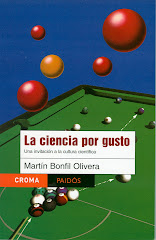by Martín Bonfil Olivera
Published on Milenio Diario, March 4, 2009
 Lots of people find their fun trying to demonstrate that science's big theories are wrong. Einstein's relativity and Darwin's evolution by natural selection are two old time favorites.
Lots of people find their fun trying to demonstrate that science's big theories are wrong. Einstein's relativity and Darwin's evolution by natural selection are two old time favorites.
Since science does not offer absolute truths, but simply knowledge that is reliable and useful, but that is in constant evolution, there's always the possibility that these critics are right. However, the usual thing is that, to begin with, they don’t have a good understanding of the theories they intend to overthrow.
One of the most common misunderstandings of Darwin's theory is the definition of a biological species. His book On the origin of species shows how they emerge, but Darwin's explanation —the varieties that appear within the same species are actually "incipient species" which, little by little, can get separated from the original— sound looks confusing. A species turns into another? When can we precisely talk about a new species? What is the difference between species, subspecies, varieties and race?
The problem is that we do not normally think in terms of populations, but of individuals. A friend of mine says he is convinced that there had to be a first human being, born from a "still not human" mother. He thinks that between both species —human and pre-human— there is a well defined border that can be crossed in one step (like the mutation that originated the Ninja Turtles)
The idea is not a dumb one: these first individuals of a new species were known as "hopeful monsters" for a long time. But, although their existence is possible, they are extremely rare cases. The normal way of things in evolution, by far, is the gradual accumulation of minimum changes that make the task of defining when a variety turns into a new species as hard as saying with precision just how many hairs a man must loose to call him bald.
In his revealing book Darwin's dangerous idea, philosopher Daniel Dennett explains that in reality, what allow us to distinguish between one species and another is the absence of intermediate individuals between two populations. When there is continuity between both, we realize that the definition of species is, in reality, a human abstraction. We'll talk more about this.
(translated by Adrián Robles Benavides)
To receive Science for pleasure weekly
in your email, subscribe here!




No comments:
Post a Comment